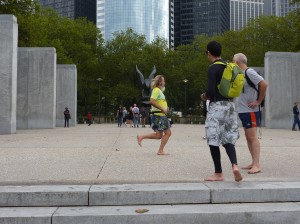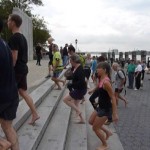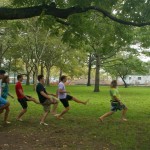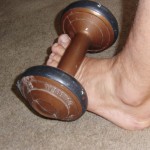Contents
- 1Tell Your Friends Where to Go!
- 2Walking and Running, Barefoot or Shod
- 3Faster, Further and Frequently
- 4Begin Here
- 5Relax
- 6Face Forward
- 7Be Upright
- 8Twist, Don't Shout
- 9Bend Knees, Hips, and Ankles
- 10Lift Feet
- 11Lead with your center, not the feet, not the shoulders, not the head!
- 12Feedback
- 13Moving Forward
- 14"Barefoot" or Minimalist Shoes
- 15Gallery
- 16Links
Tell Your Friends Where to Go!
When your Friends ask, “How can you possibly run barefoot?”
Tell them Where to Go!
How.BarefootRunning.com
Walking and Running, Barefoot or Shod
The principles on this page pertain to walking as well as running; to shod as well as barefoot, especially the principles of learning and making walking and running less work (more efficient), less stressful (more gentle), and more fun (more graceful).
Faster, Further and Frequently
You will be able to run further, faster, and more frequently, sooner, if you start at the beginning. -Ken Bobism
I’m not saying that we all must run barefoot all of the time. Not every run, or every part of a run needs to be about learning and changing and growing. But when we want to learn how to run more gently, we can learn much faster with our bare soles on stimulating terrain. Just as it’s easier to learn how to throw darts when we can see where our darts end up after we let them go, it’s easier to learn to run, when our soles can directly feel the forces traveling through them into our body.
Begin Here
All of the forces that cause the repetitive stress type injuries most common among distance runners, pass through the sole of our foot (or shoes). Therefore, it makes sense that our soles are abundantly endowed with nerves to let us know when we’re putting too much stress on our body (or soles). If it’s comfortable to run barefoot on a variety of terrains (and you should be practicing on a variety of terrains, not just comfortable terrains), then there isn’t much stress or strain being put on our soles, and therefore, not much stress or strain passing through the soles into the body to cause damage over the long term.
If the way you move hurts your soles (that’s excess stress passing through your soles, due to the way you’re standing, walking, or running), it’s likely going to injure you in other parts of your body eventually (this is precisely the reason our soles are so sensitive, they are our first warning to change the way we are moving). Run comfortably, or change the way you run so that it is comfortable (especially on rough terrain), or don’t run at all. But realize that most pains while you’re running barefoot are warning messages to change the way you are running.
Relax
Relax, relax, relax. Tension causes pain. Pain is a message that we may be leading ourselves toward injury. Avoid pain and you will learn to run more gently, more relaxed. Relax, relax, RELAX!
Face Forward
The goal of running is, at it’s simplest, to move our body forward.
We tend to move in the direction we are facing. So our face AND our feet should be facing forward.
Be Upright
A vertical building is less likely to topple over than one that is leaning. Keep the torso, head, and neck vertical and balanced on top of one another. This reduces tension and strain in trying to support a “leaning tower”.
I was going to add something about leaning a bit when accelerating wildly, like if you were sprinting… but watch Usian Bolt sprinting a mere 100 meters, he’s accelerating most of the time he is running, yet his torso has little if any detectable “lean” (except maybe the first few seconds, when he is REALLY ACCELERATING!)… For distance running, there is no need to accelerate constantly, unless we stop with each and every step (over-striding, and heel-striking). But that would be a silly waste of forward momentum!
Twist, Don’t Shout
We want to move our body forward. To do this most efficiently, our supporting foot should be landing underneath our center of balance, along a single line that is traveling in the same direction we want to run.
Hips twist to help the legs swing toward our center-line
Shoulders and hips twist in opposite directions to counterbalance each other
Unlike putting each foot down along two different but parallel lines, this twisting does not shift our weight from side to side, because the rotation is balanced and along a vertical axis, so that our center of balance continues moving forward, even as our body is twisting around the center.
While I do keep my feet following a single line, I’m not focused on keeping my feet on that single line. Instead I focus on a point in the distance in the direction I want to run. I aim, and I run! My feet follow me. Rather than trying to rotate the hips, relax, and let your hips rotate.
Bend Knees, Hips, and Ankles

Ken Bob bends his knees, NYC Barefoot Run, 2011 September 24, photo by Ivan Olarte (ivanolarte@comcast.net)
Your knees are your springs. By bending the knees, relaxing and letting your hips and ankles and knees flex naturally as your body weight loads on your feet, you are loading your natural springs. As your body moves in front of your supporting foot, the springs naturally begin to release and propel us forward. So while their is a forward push, it isn’t a conscious effort on our part to push forward.
Lift Feet
There are 3 opportunities to put excess stress of the foot while running or walking.
While barefoot on stimulating terrain, it is obvious when we are doing any or all of these. Shoes – even minimalist footwear – mute these messages.
The first, of course, is on landing, trying to point our “toes” toward the ground for a fore-foot landing.
The second, is mid-stride. Trying to stay up on the forefoot for the entire stride
The third is on lift off, or oftentimes mistaken as “push-off”.
To correct these mistakes:
- Do NOT push your feet, or point them toward the ground. In fact, I have found it helps to prevent blisters on the toes to actually curve the toes up GENTLY when the foot is landing. DO allow the toes to touch, but they should NOT be the first part of the foot touching.
- Lift your feet quickly, so your body doesn’t need to bob up and down excessively. Steps should be short (in time, not necessarily distance).
- Lift your feet early, so that your knees are bending as you land.
- Lift your entire foot, not only the heel. Instead of simply pulling your heel off the ground – leaving your toes and forefoot to bear the brunt of your weight – make a slight relaxed “effort” to lift your forefoot and toes,
Cadence
The more frequently your feet support your body, the more smoothly your body travels across the landscape. The easiest way to increase cadence is to run easily. That is, if you push your feet harder into the ground, you’re launching your body higher, which means you’ll need to wait longer between steps for your body to come back down again. That gives your gravity more time to accelerate you harder into the ground on landing. Do NOT push your feet into the ground (don’t worry, gravity will bring your foot down anyway, no need to help it). If you’re following all of the other advice on this page, your springs will be working naturally to push your body forward and up (just enough to make up for the fall between steps), so no need to try to push your feet into the ground.
In fact, in Ken Bob’s Play-Fun-Shops, we have found that simply by focusing on moving the vertical body forward (with knees bent), faster cadence will happen very easily, in the range of 190-210 or even higher.
Weight Distribution
The more of your sole that supports your body, the less the strain is on the foot. It’s the old bed-of-nails principle; a 200 pound person being supported by one small sharp pebble has 200 pounds resting on that one point. The same person using their entire sole to support them across a hundred small pebbles only has 2 pounds of pressure on each point. Relax, let your soles spread out, and comply (conform) with the terrain as much as practical.
Lift Off
Lift your entire foot. Many people who over stress their feet, do so on the trailing edge of the stride. That is, as they lift their foot off the ground, they lift the heel mostly, and the fore-foot and toes are left pushing-off, putting excess strain on the foot (and calves). Make a slight relaxed effort to lift the fore-foot (the heel will come up too)… the foot won’t actually lift off all at once, or parallel to the ground, but just putting the effort into lifting the fore-foot will take a lot of strain off the foot.
Quite often when I talk about lifting the feet and bending the knees, people want to cut out a few words and end up with “lift the knees”… which, as you can see from the following simulation leads to moving backwards (start at about 0:16):
Another common mistake is to push off with the trailing foot, instead of simply lifting. This is often done so that you can launch your body high into the air, allowing you to bring your leg forward without much need to bend the knee. This is a LOT MORE WORK, and unnecessary (the foot us lighter and less work to lift than the body). Trying to launch the body up defeats the purpose of having springy muscles in our legs, which only work if we allow our knees to bend, and load those springs. Trying to launch the body up causes greater impact on landing, because we’re falling from higher up, and have more time to accelerate. It makes our stride long (in time, not longer in length – it just feels longer, because we’re moving slower). It requires more work to push, because we have defeated the purpose of those springy muscles and tendons in our legs.
Lead with your center, not the feet, not the shoulders, not the head!
While standing in place, you can begin to run in place by lifting your feet (not launching your body up), just the feet, by bending the knees (NOT lifting the knees).
Now, simply relax your calves, let your hips fall in front of your feet (torso vertical above the hips) so that you feel like you’re going to fall forward … which is exactly what you want to do. It’s so much easier to simply fall forward than to try to push your body with your feet.
What I mean by “lead with the hips” is this isn’t a “lean”, there is no reason for the head, to be in front of your shoulders, or your shoulders in front of your abdomen, or your abdomen to be in front of your hips. These should all be stacked vertically on top of each other (preferably keeping the head on top, not on the bottom!)
Basically, we take the entire hips, torso, shoulders, head, while in good posture (vertical, but not tensely rigid), and move in front of our feet. No need to think too hard about this. Move the body forward, in the direction you want to go, and the feet will follow!
Feedback
If it hurts the soles of your feet, then you’re putting excess strain on other areas of your body too. Our sensitive soles are our first line of defense against running, literally, “senselessly”, or ignorantly.
Go back to the beginning, even if you aren’t in pain while running, go back occasionally to fine-tune, and improve your technique.
Moving Forward
Ultimately, running is about moving forward. So if nothing else, focus on moving your body (not your feet) forward. But do move your feet forward, just don’t make that your primary focus. If you move your body forward, your feet should follow.
“Barefoot” or Minimalist Shoes
Invariably, I hear from a handful of people who insist that minimalist shoes (often referred to as “Barefoot Shoes”) has helped them overcome the chronic pain and injuries that plague most runners in modern running shoes. Although I don’t encourage people to try to learn how to run barefoot while wearing footwear, it isn’t surprising that some people manage to learn to run better, despite wearing minimalist footwear. After all, a small percentage of runners in modern running shoes actually do run with good technique. So why shouldn’t a slightly larger percentage of people be able to learn how to run well in less shoes.
However, many people are not able to learn to run with less stress on their bodies and feet while wearing any form of protection on their feet. This is because most of us need the emphatic and precise feedback from our bare soles as they interact with the terrain. We are all designed to have this feedback while learning to walk and run, to ensure that we will be able to walk and run for what could be a very long life – the natural limit seems to be well over a century, for those with good genes, and healthy lifestyles.
So, you may be one of the few who can learn to run better in minimalist shoes than you were able to learn in typical modern running shoes … but how would you know that, unless you actually try it? And many of you will simply change to a technique you believe is the way you’re supposed to run while barefoot … but how would you know that, unless you actually run barefoot?
Besides, the protection of minimalist footwear, is pretty much limited to protecting our soles from abrasion – which is one reason people don’t often learn to run better while wearing them. Almost as importantly, if you believe that you should be running “UP” on the balls of your feet (DON’T), then you will be putting more stress on your foot, and the minimalist footwear doesn’t provide the support that you may be used to getting from your shoes, and if you’ve been wearing shoes for long periods, then your feet will almost necessarily not be strong enough to run in this manner without the support of more rigid shoes. Well, I’ve known many runners, not just barefoot wannabes, who have suffered stress fractures in their feet by trying to run this way in more supportive running shoes.
Bottom line, if you want to learn to run more gently, take off your shoes, and your socks, and your “Barefoot Shoes”, and let your soles feel how much force you’re putting on your feet. Then practice reducing those forces by adjusting the way you’re running.
Gallery
- Ken Bob twisting during the Dana Point Turkey Trot 10K, 2001 November 22
- Ken Bob extreme Cat-Walking, 2011 July 10
- Not that kind of cat-walk
- Group doing stair drill with Ken Bob at NYC Barefoot Run, 2011 September 24, photo by Ivan Olarte (ivanolarte@comcast.net)
- Ken Bob bends his knees, NYC Barefoot Run, 2011 September 24, photo by Ivan Olarte (ivanolarte@comcast.net)
- Ken Bob leads a cat-like tread, NYC Barefoot Run, 2011 September 24, photo by Abelardo Medenilla
- Ken Bob vertical torso, bent knees, Pacific Shoreline Marathon 2002 January 27 Huntington Beach CA
- Stiff-legged running, body moves up-and-down excessively (remember, the goal of running is to move forward, not up and down)
- Bent-knee running, up-and-down movement of the body is minimized
- Bent-knee-running
- Toe Lift exercise – use small weights, and many gentle reps
- Toes pushing against mattress gently, many reps
- Start by practicing on gentle inclines before trying to fly down the side of a cliff!
- Ken Bob cat-walking – in actual running, it’s more about relaxing and allowing the hips to rotate, rather than trying to rotate
- Do we begin with the Chicks?
- The Half-Pipe Play-Fun-Drill requires specially constructed terrain … or a wide ditch will do as well.
Links
French Translation of this page (Thanks to: Sylvain Griot)



















Pingback: Doing a Marathon Completely Barefoot with 6 Months’ Training | A Caveman Hunting On
Pingback: Född att springa « Live like a child
Pingback: Barefoot running tips for a newbie | Mark's Daily Apple Health and Fitness Forum page
Pingback: In the Heat of the Summer « Running Barefoot
Pingback: Alive and Running 10K (with a stress fracture?) « Running Barefoot
Pingback: Peter’s Canyon Summer Trail Series (2009 June 11) « Running Barefoot
Pingback: Fuss! | mozdulatlan mozgás
Pingback: Anti-Fragile Strategies for SmartPreppers | Survival Sherpa
Pingback: Anti-Fragile Strategies for SmartPreppers | The Daily Sheeple
Pingback: Brain Cramps » Anti-Fragile Strategies for SmartPreppers
Pingback: Going Barefoot | GreenJoyment
Pingback: Experiences with 'barefoot' running | CL-UAT
I was always scared to run or even walk outside barefoot. I always thought you could get more infections that way, but i have learned from sites like this that its actually healthy and can also benefit you feet from preventing things like plantar warts. i was unforutanant enough to obtain them and, they are very painful. I learned that i got plantar warts because i always kept my feet covered, and that made them soft and vulnerable. If anyone here is suffering from plantar warts, here is a site that has helped remove mine. http://www.howtoremoveplantarwarts.org
Pingback: FIVE WEIRD TIPS WHICH CAN HELP YOU RUN BETTER AND WITH FEWER INJURIES | runthings
Pingback: Lisbonne | My Trail to San Francisco
Pingback: Comment courir pieds nus (Barefoot Running – How) | la course pieds nus, la chaussure, la chaise, etc…
Pingback: Piénu cékoi – Nyxtalope
I have flat feet (both), AND a bunion on my left foot. I’m noticing wear on my left big toe in one specific spot. It’s very frustrating. Any advice or info on how to reduce this wear? Thank You